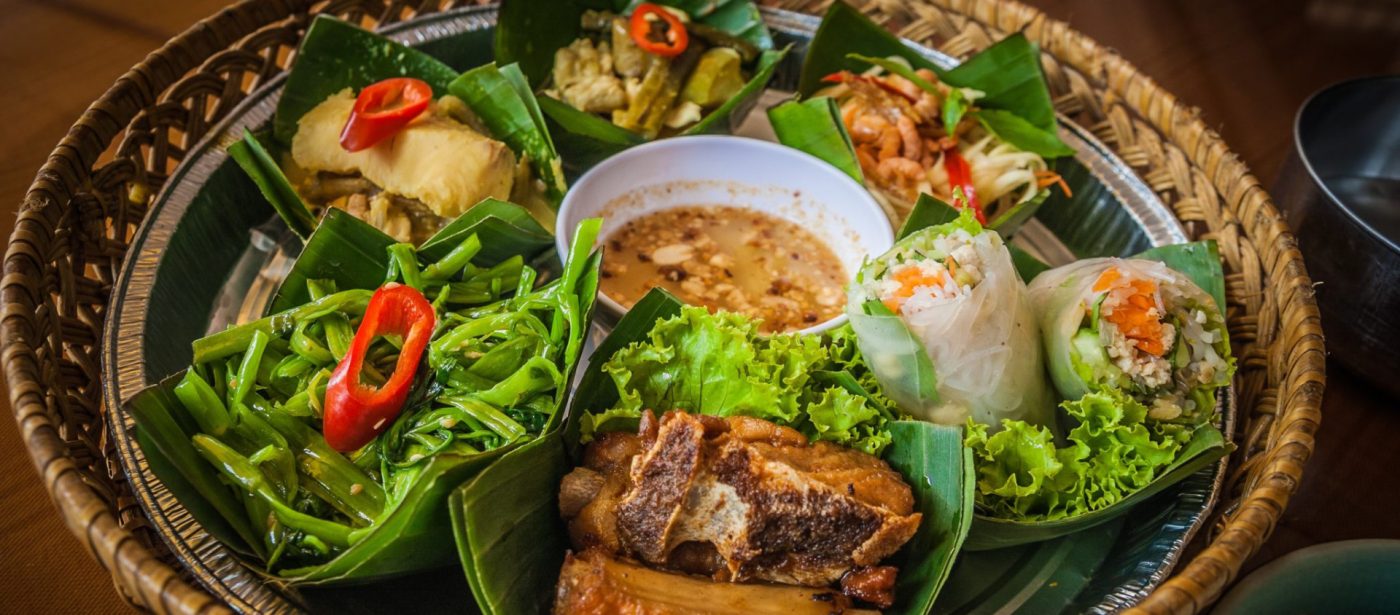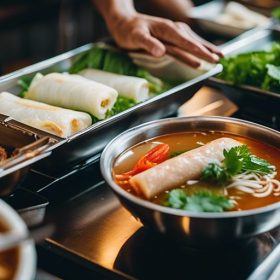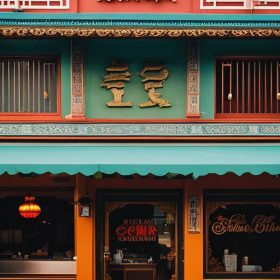Southeast Asian cuisine is known for its vibrant flavors, aromatic spices, and diverse ingredients. It is a melting pot of different cultures and influences, resulting in a unique and exciting food culture. From the fiery curries of Thailand to the fragrant noodle soups of Vietnam, Southeast Asian cuisine offers a wide range of culinary delights that are worth exploring.
The region’s cuisine is characterized by its use of fresh ingredients, bold flavors, and a harmonious balance of sweet, sour, salty, and spicy tastes. Each country in Southeast Asia has its own distinct culinary traditions and specialties, making it a fascinating destination for food lovers.
The Similarities Between Cambodian, Thai, and Vietnamese Cuisine
While each country in Southeast Asia has its own culinary identity, there are some similarities that can be found in Cambodian, Thai, and Vietnamese cuisine. One of the key similarities is the use of herbs and spices. These aromatic ingredients are used to enhance the flavors of dishes and add depth to the overall taste.
Another similarity is the emphasis on fresh ingredients. In all three cuisines, there is a strong focus on using locally sourced produce and seasonal ingredients. This ensures that the dishes are not only flavorful but also nutritious.
Lastly, rice is a staple in all three cuisines. Whether it’s steamed jasmine rice in Thailand, sticky rice in Cambodia, or fragrant rice noodles in Vietnam, rice plays a central role in Southeast Asian food culture.
The Role of Rice in Southeast Asian Food Culture
Rice is an integral part of Southeast Asian food culture. It is not only a staple food but also plays a significant role in religious ceremonies and cultural traditions. In Cambodia, for example, rice is considered sacred and is used in various rituals and offerings.
There are different types of rice used in Southeast Asian cuisine, each with its own unique characteristics. Jasmine rice, known for its fragrant aroma, is commonly used in Thailand. Sticky rice, which has a sticky texture when cooked, is a popular choice in Cambodia and Laos. In Vietnam, rice noodles are a common alternative to steamed rice.
Rice is used in a variety of dishes in Southeast Asian cuisine. It can be steamed and served as a side dish, used as a base for stir-fries and curries, or transformed into noodles for soups and salads. The versatility of rice allows it to be incorporated into a wide range of dishes, making it an essential ingredient in Southeast Asian cooking.
Spices and Seasonings: A Common Thread in Southeast Asian Cooking
Spices and seasonings are the backbone of Southeast Asian cuisine. They add depth, complexity, and a burst of flavor to dishes. Some of the most commonly used spices and seasonings in the region include lemongrass, ginger, garlic, chili peppers, fish sauce, soy sauce, and shrimp paste.
These ingredients are used to create the signature flavors of Southeast Asian dishes. Lemongrass adds a citrusy aroma, ginger adds warmth and spiciness, and garlic adds depth and richness. Chili peppers bring heat and intensity to the dishes, while fish sauce and shrimp paste add a savory umami flavor.
The combination of these spices and seasonings creates a harmonious balance of flavors that is characteristic of Southeast Asian cuisine. It is this unique blend of sweet, sour, salty, and spicy tastes that sets the region’s food apart from others.
The Importance of Fresh Ingredients in Cambodian, Thai, and Vietnamese Dishes
Fresh ingredients are at the heart of Cambodian, Thai, and Vietnamese cuisine. The use of locally sourced produce ensures that the dishes are not only flavorful but also reflect the seasonality of the ingredients.
In Cambodia, fresh herbs such as lemongrass, kaffir lime leaves, and holy basil are commonly used to add fragrance and flavor to dishes. Fresh vegetables like morning glory, water spinach, and bean sprouts are also popular choices.
In Thailand, fresh ingredients like Thai basil, cilantro, and mint are used to add a burst of freshness to dishes. Vegetables such as Thai eggplant, bamboo shoots, and green beans are commonly used in stir-fries and curries.
In Vietnam, fresh herbs like cilantro, mint, and Vietnamese coriander are essential ingredients in dishes like pho and spring rolls. Fresh vegetables like lettuce, cucumber, and bean sprouts are also commonly used in salads and noodle dishes.
The use of fresh ingredients not only enhances the taste of the dishes but also adds texture and visual appeal. It is this emphasis on freshness that makes Cambodian, Thai, and Vietnamese cuisine so vibrant and enticing.
Street Food: The Heart and Soul of Southeast Asian Cuisine
Street food is an integral part of Southeast Asian food culture. It is a way of life for many people in the region and offers a glimpse into the local culinary traditions. From bustling night markets to roadside stalls, Southeast Asia is a haven for street food lovers.
The popularity of street food can be attributed to its affordability, convenience, and the unique flavors it offers. It allows locals and tourists alike to sample a wide variety of dishes in a casual and informal setting.
Some must-try street food dishes in Southeast Asia include pad Thai in Thailand, banh mi in Vietnam, and fish amok in Cambodia. These dishes showcase the flavors and techniques that are characteristic of each country’s cuisine.
Cambodian Cuisine: A Unique Blend of Flavors and Influences
Cambodian cuisine is often overshadowed by its more well-known neighbors, Thailand and Vietnam. However, it has its own unique blend of flavors and influences that make it worth exploring.
Cambodian cuisine is characterized by its use of fresh herbs, spices, and tropical fruits. It is known for its delicate balance of flavors, with dishes that are not too spicy or overpowering. Some popular Cambodian dishes include fish amok, a fragrant fish curry steamed in banana leaves, and lok lak, a stir-fried beef dish served with rice and a tangy dipping sauce.
Influences from neighboring countries can also be seen in Cambodian cuisine. Thai and Vietnamese influences are particularly evident in the use of herbs and spices, as well as the emphasis on fresh ingredients.
Thai Cuisine: The Perfect Balance of Sweet, Sour, Salty, and Spicy
Thai cuisine is renowned for its bold flavors and harmonious balance of sweet, sour, salty, and spicy tastes. It is a culinary delight that offers a wide range of dishes to suit every palate.
One of the key characteristics of Thai cuisine is the use of fresh herbs and spices. Ingredients like lemongrass, galangal, kaffir lime leaves, and Thai basil are used to add fragrance and flavor to dishes. Chili peppers are also commonly used to add heat and intensity.
Another important aspect of Thai cuisine is the art of balancing flavors. Each dish aims to achieve a perfect harmony between sweet, sour, salty, and spicy tastes. For example, the famous Thai green curry combines the sweetness of coconut milk with the tanginess of lime juice, the saltiness of fish sauce, and the spiciness of green chilies.
Vietnamese Cuisine: A Fusion of French and Chinese Influences
Vietnamese cuisine is a fusion of French and Chinese influences, resulting in a unique culinary tradition that is both familiar and exotic. It is known for its fresh ingredients, delicate flavors, and vibrant colors.
One of the key influences on Vietnamese cuisine is French colonialism. The French introduced ingredients like baguettes, pate, and coffee, which are now integral parts of Vietnamese cuisine. The famous banh mi sandwich, for example, is a delicious fusion of French and Vietnamese flavors.
Chinese influences can also be seen in Vietnamese cuisine, particularly in the use of noodles and stir-frying techniques. Dishes like pho, a fragrant noodle soup, and stir-fried vegetables with rice noodles are popular examples of Chinese-inspired Vietnamese dishes.
Must-Try Dishes in Cambodia, Thailand, and Vietnam
When exploring the culinary delights of Southeast Asia, there are some must-try dishes that should not be missed. In Cambodia, fish amok is a must-try dish. It is a fragrant fish curry steamed in banana leaves and is a true representation of Cambodian flavors.
In Thailand, pad Thai is a classic dish that should not be missed. It is a stir-fried noodle dish that combines sweet, sour, and salty flavors with a hint of spiciness. It is often topped with crushed peanuts and served with lime wedges.
In Vietnam, pho is a must-try dish. It is a fragrant noodle soup that is typically made with beef or chicken. It is served with fresh herbs, bean sprouts, lime wedges, and chili peppers on the side, allowing diners to customize their bowl to their liking.
Exploring the Richness of Southeast Asian Food Culture
Southeast Asian cuisine offers a rich tapestry of flavors, ingredients, and culinary traditions that are worth exploring. From the aromatic spices of Cambodia to the harmonious balance of flavors in Thai cuisine and the fusion of French and Chinese influences in Vietnamese dishes, Southeast Asia has something to offer every food lover.
By delving into the culinary delights of Southeast Asia, you can experience the vibrant flavors, unique ingredients, and diverse cooking techniques that make this region’s cuisine so special. So, whether you’re a seasoned traveler or a curious foodie, don’t miss the opportunity to explore the richness of Southeast Asian food culture.

Cuong Nguyen is a talented writer and experienced waitress at Vietnampalace.net, a renowned Vietnamese restaurant that offers an extensive menu of authentic Vietnamese cuisine. With a background in the competition of Vietnamese cuisine, Cuong brings a wealth of knowledge and expertise to the dining experience. From delicious pho dishes to fresh spring rolls, Cuong ensures that every meal is made with the freshest ingredients and authentic flavors.With exceptional service and a friendly atmosphere, Cuong takes pride in providing a memorable dining experience for every customer.
Whether you’re a vegetarian looking for options or a meat lover craving the flavors of traditional Vietnamese dishes, Cuong guarantees a delightful culinary adventure. So, visit Vietnampalace.net and let Cuong guide you through the tantalizing world of Vietnamese cuisine.



